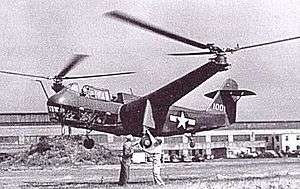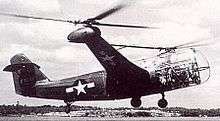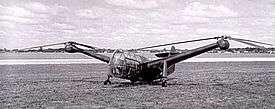Platt-LePage XR-1
| XR-1 | |
|---|---|
 | |
| XR-1 | |
| Role | Experimental helicopter |
| Manufacturer | Platt-LePage Aircraft Company |
| First flight | May 12, 1941 |
| Retired | June 21, 1946 |
| Primary user | United States Army Air Forces |
| Number built | 2 |
| Program cost | $500,000 USD[1] (equivalent to $8,060,000 in 2015) |
|
| |
The Platt-LePage XR-1, also known by the company designation PL-3,[2] was an early American twin-rotor helicopter, built by the Platt-LePage Aircraft Company of Eddystone, Pennsylvania. The winner of a United States Army Air Corps design competition held in early 1940, the XR-1 was the first helicopter tested by the USAAF, flying in 1941. The flight testing of the XR-1 proved troublesome, and although continued testing showed that the design had promise, other, improved helicopters were becoming available before the XR-1 was ready for service. As a result, the development of the aircraft was terminated in 1945.
Design and development
Developed during 1939 from an earlier, unsuccessful design, the PL-1,[3] the Platt-LePage Model PL-3 was the winner of a 1940 design competition, held under the terms of the Dorsey-Logan Act, for the supply of a helicopter design to the United States Army Air Corps.[4] Platt-LePage's submission was judged by the Army to be superior to its competitors, which included a helicopter submitted by Vought-Sikorsky, and autogyros developed by Kellett and Pitcairn.[N 1]
[2] Following the selection of the Platt-LePage design in May 1940, a contract for the construction of a prototype and a static test airframe was issued in July of that year.[2] The contract specified delivery of the flying prototype in January 1941, however the aircraft was not completed until three months later than the contract schedule,[2] a delay that led to Sikorsky receiving Dorsey-Logan Act funding for development of its design, which became the XR-4.[5]

In its design, the XR-1 bore a strong resemblance to the Focke-Wulf Fw 61, a helicopter developed by Henrich Focke in Germany that, flown by Hanna Reitsch, had impressed Platt-LePage co-founder Wynn LePage during a tour of Europe.[6] The XR-1 was powered by a Pratt & Whitney R-985 radial engine, mounted in a buried installation within the fuselage.[2] The aircraft had two, three-bladed rotors, mounted in a side-by-side arrangement on wing-like pylons.[2] The pylons were aerodynamically designed to produce some lift when in forwards flight, slightly unloading the rotors.[1] The construction of the XR-1 was conventional by the standards of the time, with the aircraft's frame consisting of a steel-tube framework, which was covered with fabric.[2] The XR-1 had tail surfaces similar to those of a conventional aircraft, and was equipped with a fixed, taildragger landing gear.[2] The aircraft's wheels freely castered for easier maneuvering on the ground.[1]
The cockpit of the XR-1 seated the aircraft's two crew members in a tandem arrangement, the pilot located ahead of the observer, and was extensively glazed to provide good visibility in the aircraft's intended observation and army co-operation role.[2] During the development of the aircraft, Major General Robert M. Danford proposed to the War Department that the XR-1 be evaluated against the Stinson YO-54 and the Kellett YG-1B autogyro.[7]
Operational history

Following several months of ground testing, the XR-1 conducted its maiden flight on May 12, 1941, although the aircraft was restrained by a tether for its early flights.[8] On June 23 the aircraft conducted its first free flight, albeit remaining within a few feet of the ground.[8] As flight testing continued and the aircraft's performance envelope was expanded, the XR-1's quickly proved troublesome, the testing showing a variety of troubles with the design.[8] These included issues with the aircraft's controls, insufficient control authority being present, and in addition there were resonance issues with the airframe[9] that made the XR-1 prone to pilot-induced oscillations.[8] The aircraft was modified in an attempt to resolve these issues, and the Army modified Platt-LePage's contract to provide additional funding for improvements to the design, but despite this the XR-1's problems continued.[8] In addition, the company's test pilot, Lou Leavitt, lacked confidence in the design, refusing to fly the aircraft to its full potential.[1] The situation was only resolved when Colonel H. Franklin Gregory, director of rotor-wing projects for the Army Air Forces, flew the aircraft himself, reaching 100 mph (160 km/h) on his first flight in the aircraft.[1]
With the worst of the aircraft's problems believed to have been resolved, the XR-1 was submitted for service testing by the Army Air Forces in 1943.[8] During the course of the Army's evaluations, the XR-1's empennage failed during structural testing, the surfaces being strengthened as a result and testing, following the repairs, resuming in 1944.[8] Despite the modifications to the design, however, the XR-1 still proved to be deficient in control authority.[8] In July 1943, the XR-1 program suffered a setback when the aircraft crashed, seriously injuring test pilot Jim Ray, who had replaced Leavitt following the latter's dismissal from the company.[1] The crash was caused by an inspector's error in leaving a suspect part on the aircraft, the rotor hub failing in flight as a result of the decision.[1] The aircraft was repairable, but it would be a year before the XR-1 was ready to fly again.[1]
Testing was, however, able to continue in the meantime, as Platt-LePage had re-negotiated the XR-1 contract to cover a second flight-test aircraft.[1] Built to a revised and improved version of the XR-1's design and designated XR-1A, the second aircraft had flown for the first time in May 1943.[8] The XR-1A featured a revised cockpit covering compared to that of the XR-1, with the area of glazing being increased for improved visibility, and the pilot and observer's positions being reversed, the pilot now seated in the rear cockpit.[8] During flight testing the XR-1A was found superior in flight performance to the XR-1;[8] however, the controls were still proving troublesome,[8] although the worst of the bugs did seem to have been worked out.[1]
Following a cross-country flight to Wright Field in Ohio from Platt-LePage's Pennsylvania plant, testing of the XR-1A continued until a mechanical failure in the rotor hub led to a crash landing[1] on 26 October 1944,[8] the company deciding to sell the wreckage for scrap.[1]
The XR-1, having been repaired in the meantime, was once again flying,[1] and a contract had been awarded to Platt-Lepage for the construction of seven pre-production aircraft, to be built to an improved version of the XR-1A design, and designated YR-1A.[10] Motivated by Congressional concerns about potential favouritism towards Sikorsky Aircraft, which had in the meantime been given a contract for development of an improved version of their VS-300 experimental helicopter, the contract called for delivery of the first YR-1A to the Army in January 1945.[10] However, due to continued financial and flight-testing problems, Platt-Lepage proved incapable of meeting this schedule.[10]
Although the XR-1's problems seemed to be approaching resolution by late 1944,[11] the protracted development of the aircraft meant that alternative, improved helicopters, such as Sikorsky's XR-4, less expensive and more maneuverable than Platt-LePage's aircraft, were becoming available.[8] In addition, even the XR-1A's improvements had failed to cure the aircraft of all of its control and vibration problems,[1] and the AAF's Air Material Command considered the company "inept" in its work, applying a "hit-or-miss method" to research and development.[1] As a result of this assessment, the Army's contracts with the company were universally cancelled in early April 1945.[8]
Following the cancellation of the Army's contract, the XR-1 was returned to the company, Platt-LePage believing that the design had potential as a civilian aircraft.[8] The planned civilian version, the PL-9, would have been an enlarged, twin-engined aircraft;[1] however Platt-LePage was by now in serious financial difficulty following the cancellation of its Army contract,[8] and in mid 1946 the XR-1's flight test program was concluded,[1] the aircraft being retired to the Smithsonian Institution.[8]
In the meantime, the company's former test pilot, Lou Leavitt, had purchased the wreckage of the XR-1A at a price of 4 cents per pound.[1] Leavitt had formed a new company, Helicopter Air Transport,[1] intending to provide helicopter flight training in anticipation of a postwar aviation boom, and he returned the XR-1A to flying condition.[10] The projected boom failed to materialise, however, and HAT quickly entered bankruptcy, Leavitt selling the XR-1A to Frank Piasecki, another former Platt-LePage employee who had now started his own helicopter company.[1] Piasecki soon grounded the aircraft due to airworthiness concerns, and used the airframe in the development of the PA-2B, a planned tiltrotor which failed to proceed beyond the mock-up stage.[1]
Survivors
Following the conclusion of flight testing, the XR-1 was returned to the Army Air Forces, who placed the aircraft in storage before donating it to the Smithsonian Institution's National Air and Space Museum.[1] The unrestored aircraft is stored at the Paul Garber Restoration and Storage Facility in "remarkable condition".[1]
Variants
- XR-1
- First prototype; one built.[2]
- XR-1A
- Second prototype with increased cockpit glazing and improved engine; one built.[8]
- YR-1A
- Seven pre-production aircraft ordered; contract cancelled before any completed.[10]
- PL-4
- Proposed armed variant of the XR-1, fitted with four machine guns in a reprofiled nose.[12]
- PL-11
- Proposed Utility/Mail single seat helicopter.
- PL-12
- Proposed five place civil helicopter, partially built in May of 1945 [13]
Operators
Specifications (XR-1A)

Data from Connor and Lee 2000; Lambermont 1958
General characteristics
- Crew: Two (Pilot and observer)
- Length: 29 ft 4 in (8.94 m)
- Wingspan: 65 ft 0 in (19.81 m)
- Height: 9 ft 0 in (2.74 m)
- Gross weight: 4,730 lb (2,145 kg)
- Powerplant: 1 × Pratt & Whitney R-985-AN-1 radial piston engine, 450 hp (340 kW)
- Main rotor diameter: 2× 31 ft 6 in (9.60 m)
Performance
- Maximum speed: 110 mph; 96 kn (177 km/h)
- Disk loading: 4.1 lb/sq ft (19.9 kg/m2)
- Power/mass: 10.8 lb (4.9kg)/hp
See also
- Aircraft of comparable role, configuration and era
- Related lists
Notes
- ↑ Despite being rejected in favour of the XR-1, the Vought-Sikorsky design would be developed into the Sikorsky VS-300, while Kellett's autogyro would be purchased for evaluation by the Army as the Kellett XR-2; Pitcairn's proposed design was the Picairn PA-36.[3]
References
- 1 2 3 4 5 6 7 8 9 10 11 12 13 14 15 16 17 18 19 20 21 22 23 24 Connor and Lee 2000
- 1 2 3 4 5 6 7 8 9 10 Francillon 1990, p.49.
- 1 2 Charnov 2003, p.171.
- ↑ Leishman 2006, p.32.
- ↑ Pattillo 2000, p.142.
- ↑ Francillon 1990, p.48.
- ↑ Raines 2002, p.42.
- 1 2 3 4 5 6 7 8 9 10 11 12 13 14 15 16 17 18 19 Francillon 1990, p.50.
- ↑ Leishman 2006, p.33.
- 1 2 3 4 5 Francillon 1990, p.51.
- ↑ Collier and Thomas 1986, p.13.
- ↑ "American airplanes: Pl-Py". Aircraft of North America 1903-2003. Aerofiles.com. 2009. Retrieved 2010-12-02.
- ↑ Platt-LePage Aircraft Company Report S-153 Preliminary model specification for Model PL-11 / PL-12 Utility mail helicopter Dr. Wynn Laurence LePage Collection
Sources
- Charnov, Bruce H. (2003). From Autogiro to Gyroplane: The Amazing Survival of an Aviation Technology. Westport, CT: Praeger. ISBN 978-1-56720-503-9.
- Collier, Larry; Kas Thomas (1986). How To Fly Helicopters (2nd ed.). Blue Ridge Summit, PA: Tab Books. ISBN 978-0-8306-2386-0.
- Connor, Roger D.; Russell Lee (2000). "Platt-LePage XR-1". Smithsonian National Air and Space Museum. Retrieved 2010-12-02.
- Francillon, René J. (1990). McDonnell Douglas Aircraft since 1920: Volume II. Annapolis, MD: Naval Institute Press. ISBN 1-55750-550-0. Retrieved 2010-12-01.
- Lambermont, Paul Marcel (1958). Helicopters and Autogyros of the World. London: Cassell. ASIN B0000CJYOA.
- Leishman, J. Gordon (2006). Principles of Helicopter Aerodynamics. New York: Cambridge University Press. ISBN 0-521-85860-7.
- Pattillo, Donald M. (2000). Pushing the Envelope: The American Aircraft Industry. Ann Arbor, MI: University of Michigan Press. ISBN 978-0-472-08671-9. Retrieved 2010-12-01.
- Raines, Edgar F., Jr. (2002). Eyes of Artillery: The Origins of Modern U.S. Army Aviation in World War II. Honolulu, HI: University Press of the Pacific. ISBN 978-1-4102-0151-5. Retrieved 2010-12-01.
External links
| Wikimedia Commons has media related to Platt-LePage XR-1. |
- "Twin Rotors", October 1944, Popular Science bottom of page 78